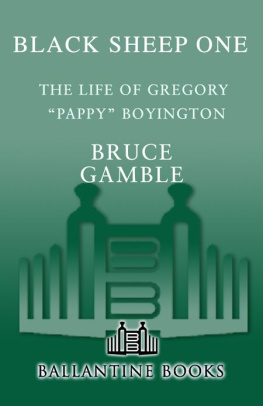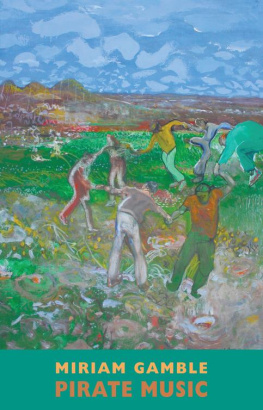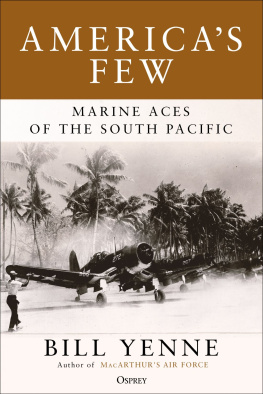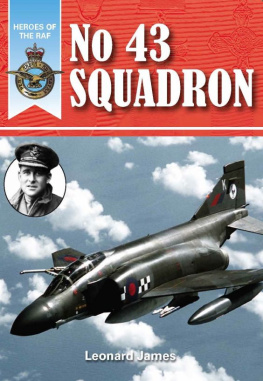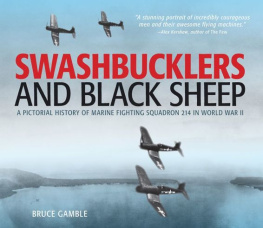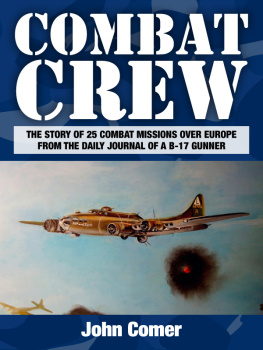Table of Contents
More praise for The Black Sheep
Cuts through the brag of Pappy Boyington to the unvarnished realities of the remarkable Black Sheep.
Stanley Weintraub Author of Long Days Journey into War
Any scrupulously fair squadron history would take some of the gloss off the Boyington myth.... But enough of the myth remainsenough to serve as a reminder of the swashbuckling Black Sheep, their screwball commander, and the planes they flew with such consummate skill.
Naval Institute Proceedings
Takes us to the Solomon Islands in the shoes of young hotshot pilots, and nudges us to experience the squalid conditions of islands so newly liberated.
ForeWord Magazine
For Ace, whose many gifts to me include the love of books,
history, and flying
ACKNOWLEDGMENTS
I would be remiss if I did not thank God first for the unusual, rewarding series of events that have shaped my life. Without them I would not have met the people who made this book possible. That includes above all my wife, Margaret, who unselfishly devoted innumerable hours above and beyond the call of duty to occupy our two young children while I wrote in peace, then provided many helpful queries regarding the manuscripts content.
I relied heavily on many others, of course. Hill Good-speed performed many hours of manuscript review at the world-class National Museum of Naval Aviation and cheerfully answered my numerous questions; Jim Curry duplicated dozens of photographs; Bill Hardman and others among the volunteer staff were indispensable. My earlier work with the museums nonprofit foundation provided the impetus for this book, and I am especially grateful to Capt. E. Earle Rogers, USN (Ret.), and Nancy Lichtman for their support.
Thanks also to Bernard Cavalcante and his staff at the Navy History Center, Naval Aviation History Branch, along with Joyce Conyers-Hudson, head of the Official Papers Unit at the Marine Corps History Center, both at the Washington Navy Yard. Other research assistants were Amy Elizabeth Stuart and Nikia Breedlove at the Still Photographs department of the National Archives Annex, and Thrsa Angelo at the Royal New Zealand Air Force Museum in Christchurch. I owe a special debt to energetic Henry Sakaida, who responded with enthusiasm and speed in sharing the results of his many years of research into Japanese records. First-class help also came from Roger Seybel at the Northrop-Grumman history center and Phil Spalla at the Igor Sikorsky archives; they provided information on F4Fs and F4Us, respectively. Corsair expert and writer Jim Sullivan donated copies from his personal archive of photographs, and Dr. Robert Mitchell assisted with aviation physiology details.
I must also acknowledge authors Paul Stillwell, Dr. Stanley Weintraub, and Barrett Tillman, who were not too busy to field questions, send encouraging letters, and help polish a first-timers manuscript. Thank you, gentlemen. Finally, two pilots who participated in the events described herein scrutinized the manuscript, then offered critical commentary: I am grateful to Col. Bruce J. Matheson, USMC (Ret.), and Col. George F. Britt, USMC (Ret.), for their priceless insight and authentication.
PREFACE
Marine Corps aviation grew by an astonishing total of ten thousand pilots during World War II, a population explosion that yielded some sixty new fighter squadrons. Today only a handful of those outfits still exists. The wartime exploits of a few pilots have been recorded by historians and aviation buffs, and their fighter planes are universally known, but the squadrons themselves and their fanciful namesthe Fighting Corsairs, the Hellhawks, the Wolfpack, the Fighting Falconshave largely been forgotten.
All, that is, except VMF-214, the Black Sheep.
They are far and away the most famous fighter squadron in American aviation history for one simple reason: No other can claim the distinction of its own network television series. Fans of the Flying Tigers might argue that they are the more famous pilots, but that nonmilitary bunch was actually three squadrons in the American Volunteer Group. In addition, no single member of a fighter squadronClaire Chennault includedhas more name recognition than the Black Sheeps famous leader, Pappy Boyington.
When Baa Baa Black Sheep first aired on NBC in 1976, it sent a handful of beautifully restored Corsairs into the living rooms of millions of viewers around the world. The aircraft dueled in pulse-racing dogfights with plenty of stereotyped Japanese villains, many of whom fell to the Corsairs chattering machine guns. After doing battle, the victorious young Marine pilots, troublemakers all (according to the opening credits), celebrated by drinking and getting into fistfights. The show unabashedly used the tried-and-true format of cowboy westerns, substituting airplanes for horses, machine guns for six-shooters, Japanese for Indians. The viewing public didnt seem to care.
As Baa Baa Black Sheep s central character, Boyington was a living legend whose autobiography of the same name had been published eighteen years earlier. He ranked as the Marine Corps all-time leading ace, and he could rightly claim distinction as one of the most colorful characters of World War II. His book became an instant classic and still remains in print. When it spawned the NBC television series, he was hired as a technical adviser.
As might be expected after Hollywood became involved, the real Black Sheep pilots were not enthusiastic supporters of the series. A few basked briefly in hometown attention, but most were incensed by uncomplimentary portrayals of their behavior. The opening credits identified them as misfits and screwballs, and during at least one contemporary talk show Boyington perpetuated the idea that they all faced courts-martial unless they went into combat with him.
As the first season premiered, a former member rose up to publicly oppose the series. Frank E. Walton, Jr., who had been the squadrons intelligence officer during Boyingtons reign as squadron commander, was a nonflier assigned to gather information, give briefings, and type reports. Older than the otherseven older than Boyingtonhe was devoted to the pilots and earned their loyalty. He found Hollywoods hokey portrayal of the squadron offensive and viewed Boyingtons participation as salt in the wound. Through a letter-writing blitz, he learned that most former Sheep were equally distressed (several briefly entertained thoughts of a lawsuit), and he decided to launch a campaign of protest through magazine articles and other media. His efforts culminated in the 1986 publication of his own book, Once They Were Eagles: The Men of the Black Sheep Squadron .
For all their public recognition, the books by Boyington and Walton covered barely four months of VMF-214s three-year operational history during World War II. More problematic is the realization that Boyingtons book is surprisingly inaccurate when compared with Marine Corps records. His statements have been widely accepted as factual for better than fifty years. After all, as a commanding officer and the recipient of a Medal of Honor, he was assumed to be forthright. But he once told an interviewer, Im a psychopathic liar, probably intending to say pathologic, in a statement that seems justified by closely examining his book.
Boyington was perhaps less concerned with veracity than he was with drama and philosophical commentary, for the result might be considered an injustice to his Marine pilots. He misspelled several of their names and identified only five members who participated in his second combat tour. Of eleven pilots killed during his tenure with the Black Sheep, he mentions only three. Many of his stated deeds did not happen as he described them, yet over the years they have become part of the very fabric of aviation history. Black Sheep myths abound.




